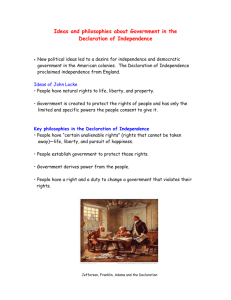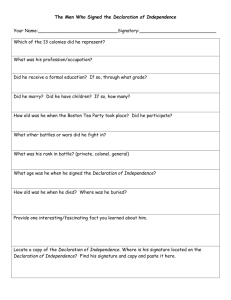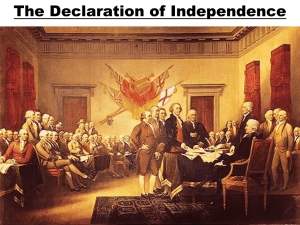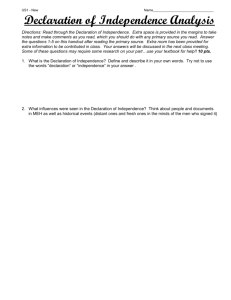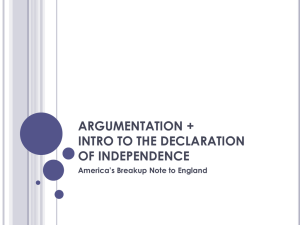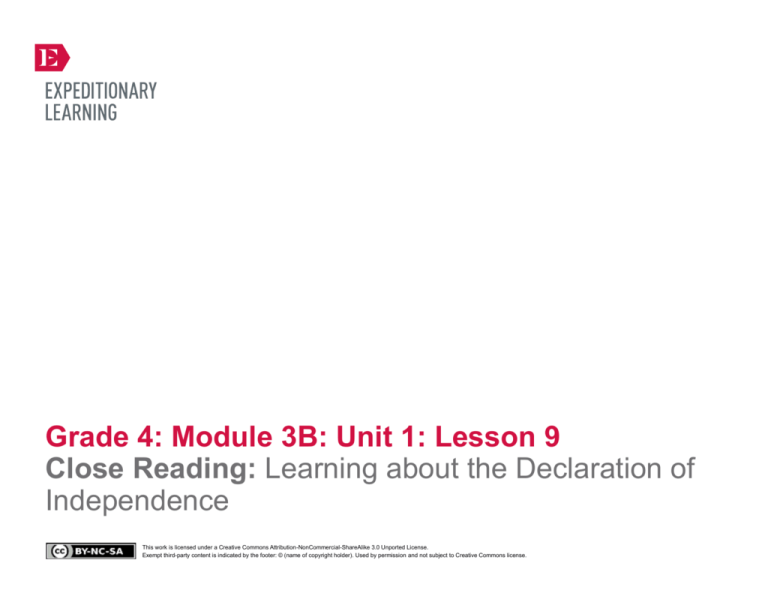
Grade 4: Module 3B: Unit 1: Lesson 9
Close Reading: Learning about the Declaration of
Independence
This work is licensed under a Creative Commons Attribution-NonCommercial-ShareAlike 3.0 Unported License.
Exempt third-party content is indicated by the footer: © (name of copyright holder). Used by permission and not subject to Creative Commons license.
GRADE 4: MODULE 3B: UNIT 1: LESSON 9
Close Reading:
Learning about the Declaration of Independence
Long-Term Targets Addressed (Based on NYSP12 ELA CCLS)
I can explain what a text says using specific details from the text. (RI.4.1)
I can make inferences using specific details from the text. (RI.4.1)
I can explain the main points in a historical text, using specific details in the text. (RI.4.3)
I can describe the organizational structure in an informational or persuasive text (chronology, comparison, cause/effect, problem/solution). (RI.4.5)
Supporting Learning Targets
Ongoing Assessment
• I can make inferences based on information from pictures and text “Thomas Jefferson and the
Declaration of Independence.”
• Close Reading note-catcher: “Thomas Jefferson and the
Declaration of Independence” (questions 1-6)
• I can support my inferences with details and examples from the text “Thomas Jefferson and the
Declaration of Independence.”
• I can explain how and why the Declaration of Independence was written.
• I can identify the organizational structure of a section of “Thomas Jefferson and the Declaration of
Independence.”
Copyright © 2013 by Expeditionary Learning, New York, NY. All Rights Reserved.
NYS Common Core ELA Curriculum • G4:M3B:U1:L9 • June 2014 •
1
GRADE 4: MODULE 3B: UNIT 1: LESSON 9
Close Reading:
Learning about the Declaration of Independence
Agenda
Teaching Notes
1. Opening
• To build on their understanding of the American Revolution and the Declaration of Independence,
students read part of the first section of the article “Thomas Jefferson and the Declaration of
Independence.” The second section of the article is read in Lesson 10. Students closely examine how and
why the Declaration of Independence was written and to think about how it impacted other events
through answering a series of text-dependent questions on their Close Reading note-catcher. Students
continue close reading process in Lesson 10 and again in Lesson 11 for the End of Unit 1 Assessment.
Preview Lessons 9-11 to get a sense of the arc of students’ work with this text.
A. Reviewing Homework and Adding to Anchor Charts
(5 minutes)
B. Reviewing Learning Targets (5 minutes)
2. Work Time
A. Reading for the Gist: “Thomas Jefferson and the
Declaration of Independence” (15 minutes)
B. Close Reading of “Thomas Jefferson and the
Declaration of Independence”: How and Why Was
the Declaration of Independence Written? (30
minutes)
3. Closing and Assessment
A. Share and Debrief (5 minutes)
4. Homework
A. Reread the introduction and first 3 paragraphs of “A
Gifted Writer” from the text “Thomas Jefferson and
the Declaration of Independence.”
B. Underline or highlight words for the Word Wall.
Choose one word and use one of your vocabulary
strategies to write a definition for this word.
• The close reading process is meant to help students deeply understand a section of the text. They read
and reread to deconstruct the meaning of the text, and then reconstruct the meaning using evidence
from the text. The teacher uses questioning geared toward a focus question to make the text accessible
to students. See the Close Reading Guide for notes on guiding student through the text and answers to
the text-dependent questions.
• The close reading process in this lesson is meant to be discussion-based; the teacher can choose to invite
students to work independently or in pairs or small groups when thinking about different questions on
the Close Reading note-catcher, but the teacher should guide the whole class in a discussion of each
section on the note-catcher using the focus question at the top before moving on to the next section.
This note-catcher is not meant to be a worksheet that is assigned to students to complete on their own.
• Row 8 of the Close Reading note-catcher asks students to reread Paragraphs 6 and 7 of “A Gifted
Writer,” which includes the following quote: “That these United Colonies are, and of right ought to be,
free and independent states.” This quote is not read closely in this lesson and is revisited in Unit 2.
• This close read sequence is designed as two lessons; however, depending on the needs of your class, you
may choose to split this close reading into three lessons.
• The end goal of Lessons 9 and 10 is for students to be able to answer the focus question on their Close
Read note-catchers. Students are given the opportunity to do so in Lesson 10.
Copyright © 2013 by Expeditionary Learning, New York, NY. All Rights Reserved.
NYS Common Core ELA Curriculum • G4:M3B:U1:L9 • June 2014 •
2
GRADE 4: MODULE 3B: UNIT 1: LESSON 9
Close Reading:
Learning about the Declaration of Independence
Agenda
Teaching Notes (continued)
• In advance:
– Review: Close Reading Note-catcher so you are familiar with the prompts and can address students’
questions as needed. See supporting materials.
– Review: Fist to Five in Checking for Understanding techniques (see Appendix).
– Review: Back-to-Back, Face-to-Face protocol (see Appendix).
– Post: Learning targets.
Lesson Vocabulary
Materials
declaration, independence; mightier
(9), self-evident, delegate (10)
• Be a Patriot anchor chart (begun in Lesson 3)
• Be a Loyalist anchor chart (begun in Lesson 5)
• Close Readers Do These Things anchor chart (begun in Module 1, Unit 1, Lesson 3)
• Close Reading note-catcher: “Thomas Jefferson and the Declaration of Independence” (one per student and one to display)
• Close Reading Guide: “Thomas Jefferson and the Declaration of Independence” (for teacher reference)
• Equity sticks
• “Thomas Jefferson and the Declaration of Independence” (one per student and one to display)
• Sticky notes (five per student)
Copyright © 2013 by Expeditionary Learning, New York, NY. All Rights Reserved.
NYS Common Core ELA Curriculum • G4:M3B:U1:L9 • June 2014 •
3
GRADE 4: MODULE 3B: UNIT 1: LESSON 9
Close Reading:
Learning about the Declaration of Independence
Meeting Students’ Needs
Opening
A. Reviewing Homework and Adding to Anchor Charts (5 minutes)
• Direct students’ attention to the Be a Patriot and Be a Loyalist anchor charts.
• Ask students to get out their homework from Lesson 8, share their paragraphs with a partner, and discuss any reasons they
think can be added to each anchor chart.
• Give students a few minutes to discuss, then call on pairs to offer additional reasons to add to each anchor chart. Listen for
and record reasons similar to the following:
– Be a Loyalist: promised freedom from slavery; receive a gun
– Be a Patriot: the idea of freedom and liberty; the words “All men are created equal”; fighting in Rhode Island bought
freedom
B. Reviewing Learning Targets (5 minutes)
• Focus students’ attention on the posted learning targets and read them aloud:
* “I can make inferences based on information from pictures and text ‘Thomas Jefferson and the Declaration of
• Discussing and clarifying the
language of learning targets helps
build academic vocabulary.
Independence.’”
* “I can support my inferences with details and examples from the text ‘Thomas Jefferson and the Declaration of
Independence.’”
* “I can explain how and why the Declaration of Independence was written.”
* “I can identify the organizational structure of a section of ‘Thomas Jefferson and the Declaration of Independence.’”
• Remind students that they have practiced the second and fourth learning targets in Lesson 7.
• Tell them that today they will think about how someone’s perspective influences his or her opinion of an event. Tell students
that they will look closely at the events that happened leading up to the writing of the final version of the Declaration of
Independence, thinking about what happened and why.
• Ask students to give a thumbs-up, thumbs-sideways, or thumbs-down to check for understanding of the targets. Clarify as
necessary.
Copyright © 2013 by Expeditionary Learning, New York, NY. All Rights Reserved.
NYS Common Core ELA Curriculum • G4:M3B:U1:L9 • June 2014 •
4
GRADE 4: MODULE 3B: UNIT 1: LESSON 9
Close Reading:
Learning about the Declaration of Independence
Work Time
Meeting Students’ Needs
A. Reading for the Gist: “Thomas Jefferson and the Declaration of Independence” (15 minutes)
• To provide more support, have
students work with their partner to
read and write the gist then share
out a section at a time.
• Tell students they will expand their understanding of the American Revolution and the Declaration of Independence by
reading an article about it over the next two days.
• Display the Close Readers Do These Things anchor chart and remind students that they will be doing all of these
things to closely read this text:
– Read small chunks of text slowly and think about the gist.
– Reread each passage one sentence at a time.
– Underline things that you understand or know about.
– Circle or underline words that you do not know.
– Talk with your partners about all of your good ideas.
– State the gist or message of the paragraph in the margin.
– Listen to the questions.
– Go back to the text in order to find answers to questions.
– Talk with your partners about the answers you find.
• Distribute and display the Close Reading note-catcher.
• Tell students that they will be using this note-catcher to help them think and take notes about this article.
• Use equity sticks to call on a student to read the focus question at the top of the Close Reading note-catcher. Remind
students that they should keep this question in mind as they work:
* “How and why was the Declaration of Independence written?”
• Distribute “Thomas Jefferson and the Declaration of Independence” and five sticky notes to each student.
• Tell them they will only be reading half of the article in the next two lessons, and reading the second half as part of the End
of Unit 1 Assessment in Lesson 11. Explain that they will read the first half of the article twice; first for the gist and a second
time to think about what happened leading up to the writing of the final version of the Declaration and why those events
happened.
• Use equity sticks to call on a student to read aloud the article’s title and subtitle.
Copyright © 2013 by Expeditionary Learning, New York, NY. All Rights Reserved.
NYS Common Core ELA Curriculum • G4:M3B:U1:L9 • June 2014 •
5
GRADE 4: MODULE 3B: UNIT 1: LESSON 9
Close Reading:
Learning about the Declaration of Independence
Meeting Students’ Needs
Work Time
• Invite students to turn and talk:
* “What does the word declaration mean? What word do you hear in the word declaration?” Listen for responses like: “I hear
the word ‘declare’ in the word declaration,” or “I think it means to declare or say something.”
• Use equity sticks to call on several students to share what they discussed with their partners. If necessary, clarify the meaning of
declaration as something stated or made known in an official way.
• Repeat with the word independence, clarifying the meaning as being free or not being controlled by anyone.
• Explain to students that the Declaration of Independence was how the Patriots formally told England that they wanted to create
their own country.
• Read aloud the first three paragraphs of the article, asking students to follow along as you do so. (“As a boy …” to “‘… has
inspired lovers of freedom everywhere.’”)
• Invite students to write a gist statement for those first three paragraphs on one of their sticky notes. If students need more
support, ask:
* “What were these paragraphs mostly about?”
• Tell students to place their sticky notes on the text by these first three paragraphs.
• Invite students to continue reading the next four sections (“A Gifted Writer,” “Expressing the American Mind,” “Hang Together—
or Separately,” and “The Test of Time”) in pairs for gist, recording a gist statement for each section on a sticky note.
• As students work, circulate and assist students. If they need support, ask:
* “What was that section mostly about?”
• Invite students to examine their gist statements for each section and write a new gist statement for the entire article.
• Use equity sticks to call on students to share their gist statements and choose one to fill in the first row of the Close Reading
Note-catcher. Listen for responses like: “This article is about the writing of the Declaration of Independence and how Thomas
Jefferson was involved with it.”
Copyright © 2013 by Expeditionary Learning, New York, NY. All Rights Reserved.
NYS Common Core ELA Curriculum • G4:M3B:U1:L9 • June 2014 •
6
GRADE 4: MODULE 3B: UNIT 1: LESSON 9
Close Reading:
Learning about the Declaration of Independence
Work Time (continued)
Meeting Students’ Needs
B. Close Reading of “Thomas Jefferson and the Declaration of Independence”: How and Why Was the
Declaration of Independence Written? (30 minutes)
• For students needing additional
support, consider allowing them to
reread the text with high-low
partners or in a targeted small
group with the teacher.
• Remind students that close readers reread the texts they are analyzing paragraph by paragraph, sentence by sentence.
• Explain to them that they will now closely reread pages 8–10 of the Thomas Jefferson article to think carefully about the focus
question:
* “How and why was the Declaration of Independence written?”
• Tell students they will be doing this by rereading and discussing with their partner, then sharing their thinking with the class.
• Using the Close Reading Guide, guide students through rereading the text, inviting them to Think-Pair-Share and discuss
the prompts as necessary.
• Stop students at the seventh row with the prompt: “Take turns reading the fourth and fifth paragraphs to your partner. Then,
working together, use details from the text to answer the questions on the right.” Tell students that they will continue
rereading the rest of the section in the next lesson.
Copyright © 2013 by Expeditionary Learning, New York, NY. All Rights Reserved.
For students needing additional
support and ELLs, consider
providing smaller chunks of text
for a close read. Teachers can
check in on students’ thinking as
they speak about their text.
NYS Common Core ELA Curriculum • G4:M3B:U1:L9 • June 2014 •
7
GRADE 4: MODULE 3B: UNIT 1: LESSON 9
Close Reading:
Learning about the Declaration of Independence
Meeting Students’ Needs
Closing and Assessment
A. Share and Debrief (5 minutes)
• Bring students back together. Invite students to use Fist to Five to show how confident they are in answering the focus
question for this article, showing a fist for being completely unsure of how or why the Declaration of Independence was
written, or a five, meaning they can share several reasons about how and why the Declaration of Independence was written.
Be sure to check in with students showing a fist, one, or two fingers during the close read in Lesson 10.
• Using the Back-to-Back, Face-to-Face protocol, ask:
* “What was one event leading up to the writing of the Declaration of Independence?”
• Listen for responses like: “The Battles of Lexington and Concord.”
• Ask:
* “How is this process helping you better understand this text?”
• Listen for responses like: “By rereading, I can think carefully about the meaning of words I don’t know like ‘delegate.’”
• Explain to students that they will continue rereading “Thomas Jefferson and the Declaration of Independence” closely in the
next lesson.
Meeting Students’ Needs
Homework
• Reread the introduction and first 3 paragraphs of “A Gifted Writer” from the text “Thomas Jefferson and the Declaration of
Independence.”
• Underline or highlight words for the Word Wall. Choose one word and use one of your vocabulary strategies to write a
definition for this word.
Copyright © 2013 by Expeditionary Learning, New York, NY. All Rights Reserved.
NYS Common Core ELA Curriculum • G4:M3B:U1:L9 • June 2014 •
8
Grade 4: Module 3B: Unit 1: Lesson 9
Supporting Materials
This work is licensed under a Creative Commons Attribution-NonCommercial-ShareAlike 3.0 Unported License.
Exempt third-party content is indicated by the footer: © (name of copyright holder). Used by permission and not subject to Creative Commons license.
GRADE 4: MODULE 3B: UNIT 1: LESSON 9
“Thomas Jefferson and the Declaration of Independence”
Copyright © Scholastic Inc. Used by permission and not subject to Creative Commons
license.
NYS Common Core ELA Curriculum • G4:M3B:U1:L9 • June 2014 •
10
GRADE 4: MODULE 3B: UNIT 1: LESSON 9
“Thomas Jefferson and the Declaration of Independence”
Copyright © Scholastic Inc. Used by permission and not subject to Creative Commons
license.
NYS Common Core ELA Curriculum • G4:M3B:U1:L9 • June 2014 •
11
GRADE 4: MODULE 3B: UNIT 1: LESSON 9
“Thomas Jefferson and the Declaration of Independence”
Copyright © Scholastic Inc. Used by permission and not subject to Creative Commons
license.
NYS Common Core ELA Curriculum • G4:M3B:U1:L9 • June 2014 •
12
GRADE 4: MODULE 3B: UNIT 1: LESSON 9
“Thomas Jefferson and the Declaration of Independence”
From Junior Scholastic , November 29, 2004. Copyright © 2004 by Scholastic Inc. Reprinted by permission of Scholastic Inc.
Copyright © Scholastic Inc. Used by permission and not subject to Creative Commons
license.
NYS Common Core ELA Curriculum • G4:M3B:U1:L9 • June 2014 •
13
GRADE 4: MODULE 3B: UNIT 1: LESSON 9
Close Reading Note-Catcher:
“Thomas Jefferson and the Declaration of Independence”
Name:
Date:
Focus question: How and why was the Declaration of Independence written?
1. What is the gist of this article?
2. Examine the picture on page 8 and
the caption for it on page 9. Then
use details from the text to answer
the questions on the right.
Who is in the picture?
What are they reading?
There are many papers on the floor in the foreground of the
picture. What might those papers be?
The caption says they were “reviewing a draft of the
Declaration of Independence.” Why were there many drafts
of the Declaration?
Copyright © 2013 by Expeditionary Learning, New York, NY. All Rights Reserved.
NYS Common Core ELA Curriculum • G4:M3B:U1:L9 • June 2014 •
14
GRADE 4: MODULE 3B: UNIT 1: LESSON 9
Close Reading Note-Catcher:
“Thomas Jefferson and the Declaration of Independence”
3. Now, reread the title, subtitle, and
introduction silently. Then use
details from the text to answer the
questions on the right.
What do you think mightier means? What words in the text
make you think so?
The text says, “For Thomas Jefferson, the pen truly was
mightier than the sword.” How could a pen be mightier than
a sword?
4. Reread the last sentence of the
second paragraph. Then use details
from the text to answer the
questions on the right.
“We hold these truths to be selfevident, that all men are created
equal.”
5. Now, reread the first two
paragraphs in the section “A Gifted
Writer.” Then use details from the
text to answer the question on the
right.
Use text features to determine what self-evident means.
What is the main point of this sentence from the Declaration
of Independence? What words in the text make you think
so?
What words does the author use to describe Thomas
Jefferson?
Copyright © 2013 by Expeditionary Learning, New York, NY. All Rights Reserved.
NYS Common Core ELA Curriculum • G4:M3B:U1:L9 • June 2014 •
15
GRADE 4: MODULE 3B: UNIT 1: LESSON 9
Close Reading Note-Catcher:
“Thomas Jefferson and the Declaration of Independence”
6. Take turns reading the third
paragraph to your partner. Then,
working together, use details from
the text to answer the questions on
the right.
Use text features to determine what delegate means.
Jefferson was sent to Philadelphia as a delegate to the
Second Continental Congress. According to the text, what
events led to the Second Continental Congress?
Why was there a Second Continental Congress?
What were the two main events described in these
paragraphs?
1.)
2.)
Stop Here. Continue with 7-11 in Lesson 10.
7. Take turns reading the fourth and
fifth paragraphs to your partner.
Then, working together, use details
from the text to answer the
questions on the right.
The text says, “Not everyone in Congress wanted
independence from Britain.” Using what you have learned in
this unit, what was the name of the group of people who did
not want independence from Britain?
What was the main event described in these paragraphs?
Copyright © 2013 by Expeditionary Learning, New York, NY. All Rights Reserved.
NYS Common Core ELA Curriculum • G4:M3B:U1:L9 • June 2014 •
16
GRADE 4: MODULE 3B: UNIT 1: LESSON 9
Close Reading Note-Catcher:
“Thomas Jefferson and the Declaration of Independence”
8. Now, reread the first two
paragraphs in the section “A Gifted
Writer.” Then use details from the
text to answer the question on the
right.
The word dissolved means brought to an end. What did
Richard Henry Lee mean when he said, “… that all political
connection between them and the State of Great Britain is,
and ought to be, totally dissolved.”
What does the word debate mean? What words in the text
make you think so?
What were the two main events described in these
paragraphs?
1.)
2.)
9. Read the seventh paragraph. Then
use details from the text to answer
the question on the right.
The text says, “At the time, no one had any idea how
important this one would turn out to be.” Why did this
proposal turn out to be so important?
Copyright © 2013 by Expeditionary Learning, New York, NY. All Rights Reserved.
NYS Common Core ELA Curriculum • G4:M3B:U1:L9 • June 2014 •
17
GRADE 4: MODULE 3B: UNIT 1: LESSON 9
Close Reading Note-Catcher:
“Thomas Jefferson and the Declaration of Independence”
10. Examine the picture and caption
on page 9. Then use details from
the text to answer the questions on
the right.
What is this a picture of?
What inferences can you make about Thomas Jefferson
based on this picture and caption?
I infer
because …
TEXT STRUCTURE
11. What is the structure of the section
“A Gifted Writer”? What words in
the text make you think so?
Summarize!
After thinking more closely about this section of the text, summarize what you think the section “A
Gifted Writer” is mostly about. Use several specific details from the text in your summary.
Copyright © 2013 by Expeditionary Learning, New York, NY. All Rights Reserved.
NYS Common Core ELA Curriculum • G4:M3B:U1:L9 • June 2014 •
18
GRADE 4: MODULE 3B: UNIT 1: LESSON 9
Close Reading Guide:
“Thomas Jefferson and the Declaration of Independence”
(Answers, for Teacher Reference)
Focus question: How and why was the Declaration of Independence written?
1. What is the gist of this article?
This article is about the writing of the Declaration
of Independence and how Thomas Jefferson was
involved with it.
2. Examine the picture on page 8 and
the caption for it on page 9. Then
use details from the text to answer
the questions on the right.
Who is in the picture?
Benjamin Franklin, John Adams, and Thomas
Jefferson
What are they reading?
a draft of the Declaration of Independence
There are many papers on the floor in the foreground of the
picture. What might those papers be?
other drafts of the Declaration
The caption says they were “reviewing a draft of the
Declaration of Independence.” Why were there many drafts
of the Declaration?
they wanted to make sure it was precise and send
the message they wanted to the British
Copyright © 2013 by Expeditionary Learning, New York, NY. All Rights Reserved.
NYS Common Core ELA Curriculum • G4:M3B:U1:L9 • June 2014 •
19
GRADE 4: MODULE 3B: UNIT 1: LESSON 9
Close Reading Note-Catcher:
“Thomas Jefferson and the Declaration of Independence”
(Answers, for Teacher Reference)
3. Now, reread the title, subtitle, and
introduction silently. Then use
details from the text to answer the
questions on the right.
What do you think mightier means? What words in the text
make you think so?
stronger “famous,” “influential”
The text says, “For Thomas Jefferson, the pen truly was
mightier than the sword.” How could a pen be mightier than
a sword?
The pen allowed Jefferson to write famous and
influential words that were stronger than fighting.
4. Reread the last sentence of the
second paragraph. Then use details
from the text to answer the
questions on the right.
“We hold these truths to be selfevident, that all men are created
equal.”
5. Now, reread the first two
paragraphs in the section “A Gifted
Writer.” Then use details from the
text to answer the question on the
right.
Use text features to determine what self-evident means.
obvious, unmistakable
What is the main point of this sentence from the Declaration
of Independence? What words in the text make you think
so?
“all men are created equal”
“freedom”
What words does the author use to describe Thomas
Jefferson?
“studious,” “reading and writing,” “had a way with
words”
Copyright © 2013 by Expeditionary Learning, New York, NY. All Rights Reserved.
NYS Common Core ELA Curriculum • G4:M3B:U1:L9 • June 2014 •
20
GRADE 4: MODULE 3B: UNIT 1: LESSON 9
Close Reading Note-Catcher:
“Thomas Jefferson and the Declaration of Independence”
(Answers, for Teacher Reference)
6. Take turns reading the third
paragraph to your partner. Then,
working together, use details from
the text to answer the questions on
the right.
Use text features to determine what delegate means.
representative
Jefferson was sent to Philadelphia as a delegate to the
Second Continental Congress. According to the text, what
events led to the Second Continental Congress?
the Battles of Lexington and Concord
Why was there a Second Continental Congress?
it was a way to gather representatives from the
colonies to discuss the war and rebelling against
Britain
What were the two main events described in these
paragraphs?
1.) The Battles of Lexington and Concord started the
war between the colonists and the British.
2.) The colonists sent representatives to
Philadelphia for the Second Continental Congress.
Stop Here. Continue with 7-11 in Lesson 10.
7. Take turns reading the fourth and
fifth paragraphs to your partner.
Then, working together, use details
from the text to answer the
questions on the right.
The text says, “Not everyone in Congress wanted
independence from Britain.” Using what you have learned in
this unit, what was the name of the group of people who did
not want independence from Britain?
Loyalists
What was the main event described in these paragraphs?
North Carolina and Virginia delegates voted for
independence
Copyright © 2013 by Expeditionary Learning, New York, NY. All Rights Reserved.
NYS Common Core ELA Curriculum • G4:M3B:U1:L9 • June 2014 •
21
GRADE 4: MODULE 3B: UNIT 1: LESSON 9
Close Reading Note-Catcher:
“Thomas Jefferson and the Declaration of Independence”
(Answers, for Teacher Reference)
8. Now, reread the first two
paragraphs in the section “A Gifted
Writer.” Then use details from the
text to answer the question on the
right.
The word dissolved means brought to an end. What did
Richard Henry Lee mean when he said, “… that all political
connection between them and the State of Great Britain is,
and ought to be, totally dissolved.”
any political connections between the colonies and
Great Britain should be brought to an end or
stopped
What does the word debate mean? What words in the text
make you think so?
discuss
“hashed out”
What were the two main events described in these
paragraphs?
1.) Richard Henry Lee proposed that the colonies
should be free and independent with no political
connection to Great Britain.
2.) A group of delegates drafted a proposal based on
Lee’s statements.
9. Read the seventh paragraph. Then
use details from the text to answer
the question on the right.
The text says, “At the time, no one had any idea how
important this one would turn out to be.” Why did this
proposal turn out to be so important?
It turned into the Declaration of Independence.
Copyright © 2013 by Expeditionary Learning, New York, NY. All Rights Reserved.
NYS Common Core ELA Curriculum • G4:M3B:U1:L9 • June 2014 •
22
GRADE 4: MODULE 3B: UNIT 1: LESSON 9
Close Reading Note-Catcher:
“Thomas Jefferson and the Declaration of Independence”
(Answers, for Teacher Reference)
10. Examine the picture and caption
on page 9. Then use details from
the text to answer the questions on
the right.
What is this a picture of?
a draft of the Declaration of Independence
TEXT STRUCTURE
11. What is the structure of the section
“A Gifted Writer”? What words in
the text make you think so?
chronology—describing a sequence of events or
measuring time
What inferences can you make about Thomas Jefferson
based on this picture and caption?
I infer
that Thomas Jefferson wanted to use very precise
language in his writing of the Declaration
because …there are so many words and phrases
crossed out and revised in the draft.
“On April 19, 1775,” “a few weeks later,” “On April
12, 1776,” “On June 7,” “For several days”
Summarize!
After thinking more closely about this section of the text, summarize what you think the section “A
Gifted Writer” is mostly about. Use several specific details from the text in your summary.
This section was about Thomas Jefferson and how he became involved in writing the
Declaration of Independence. He always had a way with words, and was selected to be a
delegate at the Second Continental Congress in Philadelphia after the Battles of
Lexington and Concord. Here, the colonists discussed the war and rebelling against
Britain. Richard Henry Lee proposed that the colonies should be free and independent
with no political connection to Great Britain. A group of delegates, including Thomas
Jefferson, drafted a proposal based on Lee’s statement. This proposal would become
the Declaration of Independence.
Copyright © 2013 by Expeditionary Learning, New York, NY. All Rights Reserved.
NYS Common Core ELA Curriculum • G4:M3B:U1:L9 • June 2014 •
23


